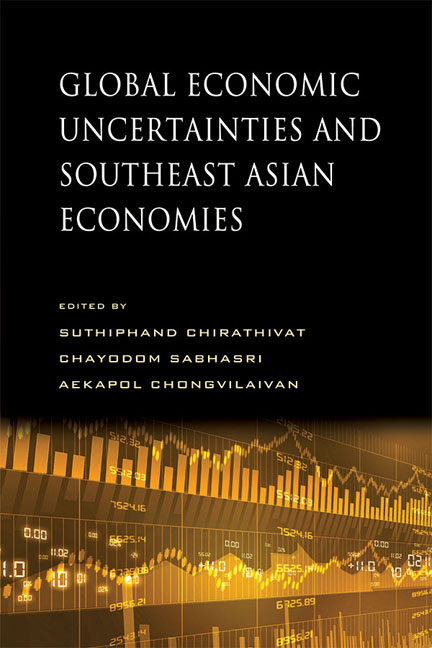Book contents
- Frontmatter
- Contents
- Preface
- Contributors
- 1 Challenges Facing a Globally Connected ASEAN
- 2 Fragile Balance of Payment in Indonesia under Global Economic Uncertainties
- 3 Malaysia in the Midst of Global Economic Uncertainties
- 4 Singapore: Reinventing Itself amid Global Economic Uncertainties
- 5 Thailand: Dependency or Diversification?
- 6 Vietnam's Economic Experience since WTO Accession
- 7 Global Economic Imbalances and Reform Policy: Evidence from Asian Economies
- 8 Foreign Exchange Rate Adjustment Policies in Asia
- 9 Monetary and Financial Architectures for ASEAN+
- 10 Global Uncertainties: Implications for the ASEAN Community
- Index
10 - Global Uncertainties: Implications for the ASEAN Community
Published online by Cambridge University Press: 22 July 2017
- Frontmatter
- Contents
- Preface
- Contributors
- 1 Challenges Facing a Globally Connected ASEAN
- 2 Fragile Balance of Payment in Indonesia under Global Economic Uncertainties
- 3 Malaysia in the Midst of Global Economic Uncertainties
- 4 Singapore: Reinventing Itself amid Global Economic Uncertainties
- 5 Thailand: Dependency or Diversification?
- 6 Vietnam's Economic Experience since WTO Accession
- 7 Global Economic Imbalances and Reform Policy: Evidence from Asian Economies
- 8 Foreign Exchange Rate Adjustment Policies in Asia
- 9 Monetary and Financial Architectures for ASEAN+
- 10 Global Uncertainties: Implications for the ASEAN Community
- Index
Summary
INTRODUCTION
The Association of Southeast Asian Nations (ASEAN) is a unique mixture of ten national economies at different stages of social and economic development, ranging from affluent Singapore to underdeveloped members, for example Myanmar, Cambodia and Laos. Embracing a more region-centred growth model, the process of ASEAN Community building has been monitored through various economic stimulus measures as well as the system of Dialogue Partnerships, the ASEAN Regional Forum, the ASEAN+3 process, and the East Asia Summit (ISEAS 2010) to successfully establish the ASEAN Community by 2015. The global uncertainties, however, remain potentially huge risks that will need to be effectively managed.
Since the Asian Financial Crisis in 1997, Southeast Asian countries have witnessed social deficits and the collapse of financial sectors. The process of ASEAN Community building has therefore been tested by uncertainties arising from internal and external challenges, particularly from advanced economies in the European Union, Japan, and the United States. These phenomena have significant implications on the establishment of ASEAN Vision 2020 and the plans for the ASEAN Community by 2015 (Srisangnam and Thamanovanish 2013).
The global uncertainties could thus be identified in terms of financial risks and non-financial risks, which illustrate the interconnectedness of economic and security issues within the region. ASEAN governments together with their counterparts, particularly those of ASEAN+3 countries, have been working closely to drive the region in the right direction.
FINANCIAL RISKS
Prior to the Asian Financial Crisis in 1997, most Southeast Asian countries had seen the flow of liquidity from European countries, the United States, and Japan injected into the global financial system — especially that of Southeast Asia — in search of higher returns. This short-term capital inflow owned by non-residents leads to the country's macroeconomic instability and harms the entire economy when the capital starts to flow out. The Global Financial Crisis in 2007 to 2008 deepened the financial turmoil in vulnerable Southeast Asian economies. The average GDP growth rate in ASEAN countries slowed down from 6.5 per cent in 2007 to 1.2 in 2009 due to export-oriented policies and weak macroeconomic management frameworks (SEAISI 2011).
Along with the global economic uncertainties generated by macroeconomic difficulties in advanced economies and the further economic slowdown of China, ASEAN is in dire need to restore confidence in the financial market, prevent the emergence of financial crises, and maintain growth.
- Type
- Chapter
- Information
- Global Economic Uncertainties and Southeast Asian Economies , pp. 242 - 255Publisher: ISEAS–Yusof Ishak InstitutePrint publication year: 2015



